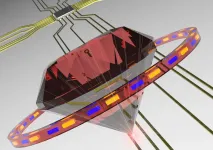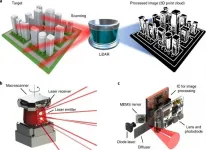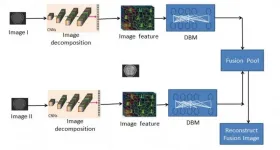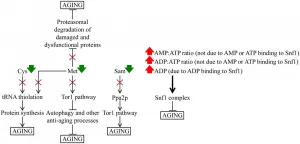(Press-News.org) A long noncoding RNA whose function was previously unknown turns out to play an important role in promoting the body's immune response against cancer and holds promise for enhancing the efficacy of anti-cancer immunotherapy.
That's according to new findings reported in Nature Cell Biology by researchers at the University of Michigan Rogel Cancer Center.
The group dubbed the RNA they identified LIMIT -- for long noncoding RNA inducing major histocompatibility complex class I and immunogenicity of tumor.
"LIMIT is easy to remember, but really it does the opposite. It stimulates immune functions against cancer," says senior study author Weiping Zou, M.D., Ph.D., the Charles B. de Nancrede Professor of Pathology, Immunology, Biology, and Surgery at U-M.
Only a small part of the human genome contains genes that encode proteins. The rest includes more than 30,000 long "noncoding" RNAs, or lncRNAs, most of whose functions remain unknown.
LncRNAs are known to play some important roles in cancer, but very little is known about their roles in the context of the immune system's response to cancer, Zou says.
"LncRNAs have mainly been studied in cancer models that lack a functioning immune system, leaving a big gap in our knowledge," adds study first author Gaopeng Li, Ph.D., a research fellow in Zou's lab. "When it works, immunotherapy can be amazingly successful, but doesn't work in more than half of patients. We wanted to better understand what role lncRNAs play and whether there might be opportunities to target them to improve immunotherapy."
Immunotherapy tends to be most effective in patients with whose tumors are more susceptible to infiltration by the immune system's T cells. By comparing cancers with low levels of T cell infiltration to those with high infiltration, the researchers discovered LIMIT through its association with positive markers of immune response.
After confirming that LIMIT was indeed a long noncoding RNA, the researchers conducted experiments in human tumor cells and mouse cells to better understand its function, explains Zou. And it turns out that LIMIT is regulated by interferon gamma, a cytokine that plays a central role in the body's ability to mount an immune response against an invading threat.
Subsequent experiments in mice showed that LIMIT is a vital component of T cell infiltration into tumors.
"If you get rid of this lncRNA, the mice are much less able to fight off the cancer," Zou says. "The T cells don't go to the tumor and they don't function normally."
Ultimately, the research determined that LIMIT activates a family of genes known as GPBs (for guanylate binding proteins), leading to the activation of other important immune players: heat shock factor-1 (HSF1) and major histocompatibility complex class I (MHC-I).
Using CRISPR techniques to activate LIMIT boosted checkpoint therapy against the tumors in mouse models, while silencing LIMIT made the immunotherapy less effective.
"Very often, there is a loss of MHC-I and interferon gamma signaling in human tumors, which helps the cancer evade the immune system," Zou says. "Our research suggests several new potential therapeutic approaches to overcome this. These include using CRISPR to activate LIMIT and improve MHC-I expression to boost the body's immune response, and also targeting some of the downstream players in this signaling axis, like GBPs."
INFORMATION:
Additional authors include Ilona Kryczek, Jutaek Nam, Xiong Li, Shasha Li, Jing Li, Shuang Wei, Sara Grove, Linda Vatan, Jiajia Zhou, Wan Du, Heng Lin, Ton Wang, Chitra Subramanian, James J. Moon, Marcin Cieslik, Mark Cohen, all of U-M.
This work was supported by grants from the National Cancer Institute (CA217648, CA123088, CA099985, CA193136, CA152470, CA216919, CA213566, CA120458) and the National Institutes of Health through a grant to the U-M Rogel Cancer Center (CA46592).
Paper cited: "LIMIT is an immunogenic lncRNA in cancer immunity and immunotherapy," Nature Cell Biology. DOI: 10.1038/s41556-021-00672-3
Researchers at the University of California, Davis, have found a link between traffic-related air pollution and an increased risk for age-related dementia, including Alzheimer's disease. Their study, based on rodent models, corroborates previous epidemiological evidence showing this association.
Alzheimer's disease is the most common cause of age-related dementia and the sixth leading cause of death in the United States. More than 5 million Americans currently live with Alzheimer's disease -- a number that is expected to triple by 2050 as the population ages. ...
In patients receiving therapeutic hypothermia after suffering out-of-hospital cardiac arrest, those who were cooled below 31 degrees Celsius (about 88 degrees Fahrenheit) for 24 hours showed no difference in terms of death or poor neurological outcomes at six months compared with patients receiving guideline-recommended cooling of 34 C (about 93 F). These findings are part of a study presented at the American College of Cardiology's 70th Annual Scientific Session.
Therapeutic hypothermia is a procedure in which a person's body is cooled far below normal body temperature. It has been shown to improve survival and reduce brain damage in people who have been resuscitated but remain comatose after suffering cardiac arrest (when the heart stops ...
Sperm are generally viewed as having just one action in reproduction - to fertilise the female's egg - but studies at the University of Adelaide are overturning that view.
Published in Nature Research journal Communications Biology, new research shows that sperm also deliver signals directly to the female reproductive tissues to increase the chances of conception.
Robinson Research Institute's Professor Sarah Robertson, who led the project, said: "This research is the first to show that the female immune response is persuaded by signals in sperm to allow the male partner ...
Marilyn Monroe famously sang that diamonds are a girl's best friend, but they are also very popular with quantum scientists - with two new research breakthroughs poised to accelerate the development of synthetic diamond-based quantum technology, improve scalability, and dramatically reduce manufacturing costs.
While silicon is traditionally used for computer and mobile phone hardware, diamond has unique properties that make it particularly useful as a base for emerging quantum technologies such as quantum supercomputers, secure communications and sensors.
However there are two key problems; cost, and difficulty in fabricating the single crystal diamond layer, which is smaller ...
The nanophotonics-based LiDAR technology developed by a POSTECH research team was presented as an invited paper in Nature Nanotechnology, the leading academic journal in the field of nanoscience and nanoengineering.
In this paper, a POSTECH research team (led by Professor Junsuk Rho of the departments of mechanical engineering and chemical engineering, postdoctoral researcher Dr. Inki Kim of the Department of Mechanical Engineering, and Ph.D. candidate Jaehyuck Jang of the Department of Chemical Engineering) in cooperation with the French National Science Institute (CNRS-CRHEA) focused on the LiDAR device developed through studying the metamaterials based ultralight nanophotonics.
In addition, the paper ...
Image fusion is a process that can enhance the clinical value of medical images, improving the accuracy of medical diagnoses and the quality of patient care.
Researchers at the College of Data Science Software Engineering at China's Qingdao University, have developed a new 'multi-modal' image fusion method based on supervised deep learning that enhances image clarity, reduces redundant image features and supports batch processing. Their END ...
ATS 2021, New York, NY - The COVID-19 pandemic has, and will continue to have, a tremendous impact on ICU nurses' mental health and willingness to continue in the critical care work force, according to research presented at the ATS 2021 International Conference.
Jill Guttormson, PhD, RN, associate dean for Academic Affairs and associate professor, College of Nursing, Marquette University, and colleagues sought to describe the impact of COVID-19 on ICU nurses through a survey using valid and reliable measures of burnout, moral distress, depression, anxiety, and posttraumatic stress symptoms.
The researchers recruited a national sample of nurses who have worked in the ICU during the COVID-19 pandemic between October and ...
The cover for issue 7 of Oncotarget features Figure 14, "A hypothetical model of how a specific remodeling of cellular metabolism by CR slows down yeast chronological aging," published in "Caloric restriction creates a metabolic pattern of chronological aging delay that in budding yeast differs from the metabolic design established by two other geroprotectors" by Mohammad, et al. which reported that caloric restriction and the tor1Δ mutation are robust geroprotectors in yeast and other eukaryotes.
The authors demonstrate that caloric restriction generates a unique metabolic pattern.
Unlike the tor1Δ mutation or lithocholic acid, it slows down the metabolic pathway ...
A team of McMaster University researchers who studied heart patients found that stair-climbing routines, whether vigorous or moderate, provide significant cardiovascular and muscular benefits.
The findings, published in closely related studies in the journals Medicine & Science in Sports & Exercise and Frontiers, address the most frequently cited barriers to exercise: time, equipment and access to gym facilities.
"Brief, vigorous stair-climbing and traditional moderate intensity exercise both changed fitness, which is a key predictor of mortality after a cardiac event," says Maureen MacDonald, one of the lead researchers on both studies and a professor in McMaster's Department ...
Oncotarget published "The cancer testis antigens CABYR-a/b and CABYR-c are expressed in a subset of colorectal cancers and hold promise as targets for specific immunotherapy" which reported that Calcium-binding tyrosine phosphorylation-regulated protein is expressed in the human germ line but not in adult human tissues, thus, it is considered a cancer testis protein.
The aim of this study is to evaluate the CABYR isoforms: a/b and c mRNA expression in colorectal cancer and to determine if these proteins hold promise as vaccine targets.
CABYR mRNA expression in a set of normal human tissues, including the testis, were determined ...





